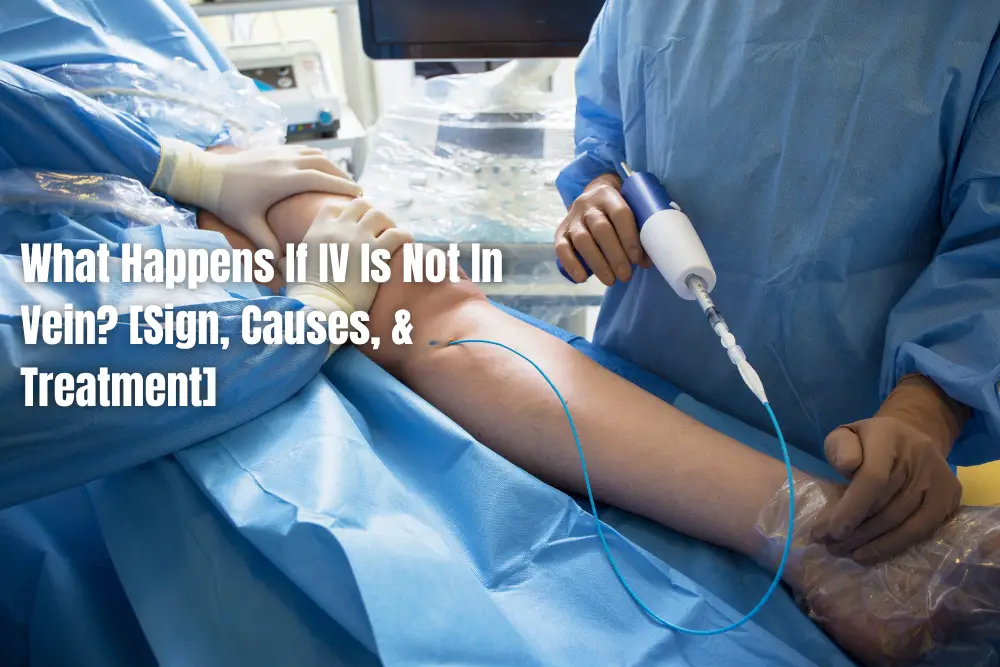In the health and medical field, there are a number of risks associated with incorrect IV (intravenous) injections. Some of these risks include infection, injury, and even death. If you or someone you know has received an incorrect IV injection, it’s important to know what to do. In this post, we’ll outline the steps you should take if you believe that you or someone you know has been given an incorrect IV injection.
What happens If the IV is not in the vein? If IV Injection is not administered in the vein, it can lead to serious health consequences. This includes infection of the bloodstream (sepsis), which can be deadly if left untreated. Other side effects of an incorrect injection include damage to muscles and nerves, fluid accumulation in the lungs (pulmonary edema), paralysis, and even death.
Where does IV go if it’s not in vain? There are three possibilities for leaked IV Injection. First, the drug may not enter your bloodstream as it should because it would then be going directly to your lungs. This could lead to side effects and even death. Second, the drug may be delivered to the wrong area because the veins in your arm are not as big as those in your leg. Third, the needle may go too deep into a vein and damage it. If any of these things happen, you should immediately seek medical attention.
What Is an IV & Why It Should Be In Vein
An IV, or intravenous injection, is a medical procedure in which medication or other fluids are directly injected into the veins through an inserted needle. IVs are often used to treat patients with critical conditions who cannot take oral medications by mouth. They can also be administered for therapeutic purposes such as administering antibiotics and pain relief medications.
Intravenous injection (IV) should be in the vein for many reasons, including but not limited to:
- To administer life-saving medications quickly and easily.
- To provide fluids and other critical medical necessities when conventional methods are unavailable or ineffective.
- To stabilize patients during surgery or other procedures where they may experience intense pain or discomfort.
What Happens When IV Is Not In Vein
If IV is not in vain, the person may experience complications such as infection and blood clots. There is the possibility that the needle may go in too far and starts to injure surrounding tissue. This can lead to infection, pain, and swelling. In some cases, the needle may even break and need to be replaced.
If you are uncertain about how to properly inject an IV drip, or if you notice any signs of injury or poisoning after administering it, call 911 immediately!
So, make sure you’re familiar with safe techniques for administering IV treatments, and always take into account the patient’s specific health condition when administering any type of medication.
IV Not In Vein: Infiltration & Extravasation
Infiltration and extravasation can occur when an intravenous (IV) line is not in the vein. Infiltration occurs when fluids or blood enter the air spaces of the lungs. Extravasation happens when fluid accumulates outside of the body, most commonly in the extremities.
Signs and symptoms of infiltration or extravasation include difficulty breathing, chest pain, coughing up blood or white foam from mouth and nose, and lightheadedness-fainting spells.
Infiltration
When it comes to IV injections, it’s important to be familiar with infiltration. Infiltration is the process of an IV injection entering the body other than through the vein, which can lead to infection and inflammation. If this does not occur in the vein, it can cause infection and inflammation of other tissues around the body. Infiltration can also lead to a number of serious health conditions, including sepsis or blood poisoning. Always make sure that an IV injection is administered by a certified healthcare professional, and seek immediate medical attention if you experience any symptoms of infiltration. With a little bit of knowledge and vigilance, you can keep your health safe and healthy during any IV injection procedure.
Extravasation
When it comes to an IV injection, no one knows it better than professionals. However, even they can make a mistake. That’s why it’s so important to know the signs and symptoms of extravasation – otherwise, you could be in for a blood bath. Extravasation is when fluid from the circulatory system leaks out of a vein and into surrounding tissue or the body cavity. If you notice any of the following symptoms, it’s time to contact your doctor: Strange color changes in your blood Sudden swelling Faintness Nausea and vomiting Rapid heart rate Extravasation can be caused by a number of factors, but the most common are accidental punctures and overuse of IVs. If you’re ever in doubt about an IV injection, err on the side of caution and contact your healthcare provider. In the meantime, keep your injections clean and within the prescribed dosage – failure to do so can lead to serious health complications.
IV Not In Vein: Causes
There are a few reasons why an IV might not be placed in the appropriate vein. Here are five of the most common causes:
1. The nurse didn’t properly assess the patient’s vascular system before inserting the IV.
2. The needle or catheter is too big or small for the vein they’re trying to insert it into.
3. The veins have been damaged due to surgery, advanced age, or other factors – this can often happen when a person has recently lost weight, exercised heavily, had a high fever, or undergone other strenuous activity.
4. Poorly trained nurses may use brute force instead of smooth techniques when inserting an IV catheter – this can damage nearby veins and arteries as well as muscles and tendons near where the insertion is taking place!
5. An over-the-counter painkiller (such as ibuprofen) may weaken blood vessels – even if taken only for short periods of time – and make them more susceptible to injury from an intravenous injection
6. Increased Vein Porosity- the incorrect IV injection can go into an artery, which can lead to increased vein porosity and infection. In some cases, this increase in vein porosity can also lead to clots or blockages.
IV Not In Vein: Signs
If you are using an IV injection to receive medication or treatments, there is a very small chance that the needle will go into a vein other than the one intended. This can lead to serious health problems, and it’s important to be aware of the signs or symptoms of this situation so that you can take necessary action.
Here are some common signs or symptoms of IV injection not in vein:
- Feelings of lightheadedness, dizziness, vomiting, difficulty breathing, chest pain
- Redness and swelling around the area where the needle was inserted
- Sharp pain when injecting medication
- Fever & Chills
- Not feeling well at all after receiving an injection
- Chills
- Throbbing sensations (especially around the heart
IV Not In Vein: Treatment
If you experience any of the signs or symptoms listed above, it’s important to seek medical attention as soon as possible. Treatment may include having the vein checked to see if it’s damaged, receiving emergency antibiotics if there is an infection present, and/or seeking surgery in rare cases where the vein cannot be repaired.
Who Is At Fault for IV Injury?
Anyone who has undergone an IV injection knows that it can be a risky business. But what happens if the injection isn’t placed in the vein? This is a question that has been asked time and time again, with many people blaming the nurse or doctor who performed the injection. In many cases, these injuries can lead to serious complications and even death. It is important to know who is at fault for an IV injury, as this may help to ensure that future complications are avoided. As a rule of thumb, IV injection is a common medical procedure, but it should only be done by experienced professionals who are aware of the risks. If you are ever injured as a result of an IV injection, it is important to seek medical attention as soon as possible.
Do I Have a Malpractice Case For An IV Mistake?
If you have been injured as a result of an IV injection not being placed in the vein, you may have a case for malpractice. This can result in serious medical complications and even death. If you believe you may have suffered as a result of this mistake, it’s important to speak to your doctor as soon as possible. You may be able to pursue legal action if necessary, but knowing your rights is key before making any decisions. Always speak to a lawyer if you are unsure about your rights or if you feel you may have a valid case.
How to avoid complications during IV injection: Tips
If you’re ever faced with a complication during an intravenous (IV) injection, there are several things you can do to ensure the best possible outcome.
- Make sure the IV is clean and free of any debris or other objects that could block the needle.
- Verify that your dosage has been entered correctly into the syringe; double-check to make sure all units in milliliters (ml) have been accounted for.
- Avoid injecting too fast – this will cause air bubbles to form, which can increase the risk of complications. Slowly inject the dose over a 10-minute period while monitoring closely for signs of adverse effects (such as chest pain, tachycardia, and hypotension).
- If necessary, seek emergency medical attention immediately; IV injections should never be attempted without first consulting a doctor.
Frequently Asked Questions
How do you know if an IV is incorrect?
It is important to be familiar with the warning signs of an incorrect IV injection.
Some of the most common symptoms of an incorrect IV injection are muscle pain, redness and swelling at the insertion site, fatigue, fever, and chills. If you experience any other unusual side effects while taking medications by IV infusions – such as shortness of breath or chest pains – please contact your healthcare provider immediately too. A wrong dose or delivery method could be causing these problems.
What is it called when the IV is not in the vein?
Infiltration and extravasation are two terms that are used to describe when an infusion or a medication leaks from the vein. Infiltration refers to when the medication enters into surrounding tissue and extravasation refers to when the IV of the infusion or medication leaks from the vein. Infiltration and extravasation can both lead to serious health complications, including infection and even death. So be sure to get your IV injections placed in the right vein every time!
Can veins be damaged by IV?
Yes, veins can be damaged by IV injection. This is due to the fact that needles are usually inserted into smaller blood vessels near the surface of the skin. When these small veins are punctured, they may become inflamed and damaged. So please take caution when administering injections – make sure you always follow proper safety procedures to minimize the risk of injury or contamination
What happens when saline misses the vein?
If saline is not injected into the vein, then it will flow out of the site and enter your bloodstream. This is known as a blood transfusion reaction and can be very dangerous. In some cases, too much salt can get into the bloodstream and cause water intoxication or hyponatremia.
Conclusion
Now you know that IV injections can have grave consequences. This is why it’s very important to be careful while performing such injections.
If you are afraid of making a mistake when giving an IV injection, consult a doctor and follow their advice. Also, educate your family members about the risk of not using proper techniques while administering IV injections.

